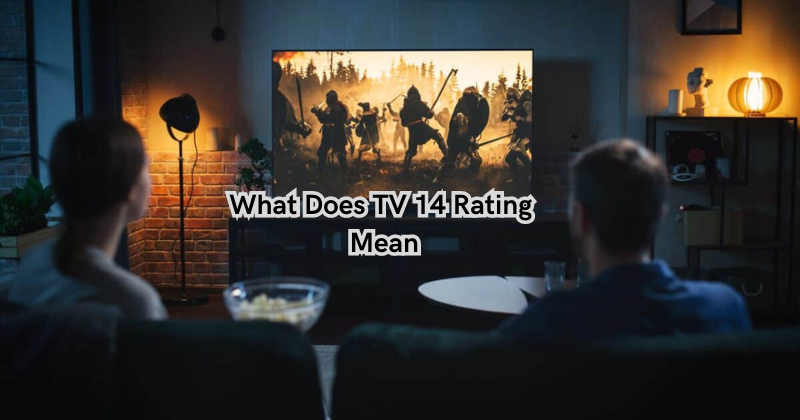The TV-14 rating is a content advisory classification assigned by the TV Parental Guidelines to indicate that the program may contain material unsuitable for children under 14.
This rating suggests that the show may include intense violence, strong language, sexual content, or suggestive dialogue, making it potentially inappropriate for younger audiences. It serves as a guide for parents and guardians to make informed decisions about what their children watch.
Understanding the TV-14 rating helps viewers assess the suitability of a program based on its content, ensuring a safer and more age-appropriate viewing experience for young audiences. Further in this guide, we will discuss the meaning of TV-14 rating and the type of content in a TV-14-rated program.
What is TV-14?
The TV-14 rating is a classification that falls under the TV Parental Guidelines system in the United States. This system was created by the Federal Communications Commission (FCC) to guide parents and guardians regarding the content of television programs.
It is meant to help viewers make informed choices about what they watch based on their standards and values. The TV-14 rating is one of the more strict classifications, indicating that a program may contain content unsuitable for children under 14.
What Does TV 14 Rating Mean?
The TV-14 rating warns parents and guardians that the program may contain content unsuitable for younger audiences. This includes violence, strong language, sexual content, and suggestive dialogue. However, it does not necessarily mean that all of these elements will be present in every TV-14-rated program - it simply serves as a general advisory.
Furthermore, the rating does not necessarily apply to the entire program but to specific episodes or segments within a show. This means that while one episode of a TV-14-rated series may contain intense violence, another may only have mild language.
Content Descriptors
In addition to the TV-14 rating, programs may have specific content descriptors that give further information about the type of content in a show. These descriptors include V (violence), L (coarse language), S (sexual content), and D (suggestive dialogue).
These descriptors are meant to provide more specific information about the type of content that may be present in a program, giving viewers a better idea of what to expect.
While not all TV-14-rated programs will have all these descriptors, they warn viewers about potentially sensitive topics or scenes that may be inappropriate for younger audiences. For example, a TV-14 V rating indicates the presence of intense violence, while a TV-14 L rating suggests the use of strong language.
Time-based restrictions
Another critical aspect of the TV-14 rating is the time-based restrictions that may be applied to specific programs. This means that a program with a TV-14 rating may only air during certain hours, typically after 8 pm, when younger children are less likely to watch television.
Additionally, some programs may have parental controls or age verification requirements to view them, ensuring the content is suitable for the designated audience.
Examples of Popular Shows with TV-14 Rating
Some popular shows that have been given a TV-14 rating include "The Walking Dead," "Breaking Bad," and "Game of Thrones." These shows are known for their intense violence, strong language, and mature themes.
It is important to note that the TV-14 rating does not necessarily restrict these shows from being viewed by younger audiences but rather serves as parental guidance to assist in making informed decisions.
Why is it Important to Understand the TV-14 Rating?
Understanding the TV-14 rating allows viewers to make informed decisions about what they or their children watch. It helps parents and guardians determine if a program suits their child's age and maturity level, ensuring they are not exposed to potentially harmful or inappropriate content.
In fantasy violence and other forms of media, exposure may lead to children imitating the behavior they see. By understanding the TV-14 rating, parents can protect their children from being exposed to inappropriate content and help foster healthy media consumption habits.
Moreover, the TV-14 rating also serves as an alert for viewers who may be sensitive to specific topics or scenes. By knowing the rating and descriptors of a program, viewers can decide whether they wish to watch it. Maybe little or no violence is acceptable to one viewer, while another may not mind strong language or sexual content. By understanding the TV-14 rating and its associated descriptors, viewers can make a more educated decision about what they watch.
How to Understand the TV Rating System Better
To better understand the TV-14 rating and other classifications, one must familiarize oneself with the TV Parental Guidelines. Here is a breakdown of the different age-based ratings:
TV-Y: Appropriate for all children
This rating is suitable for children of all ages, with no offensive material present. It is seen in educational and wholesome programming. Furthermore, it may include some mild fantasy violence or comedic slapstick.
TV-Y7: Designed for children age 7 and up
This rating suggests the program may contain mild fantasy violence, scary moments, or comedic insults. However, no strong language is present. So younger children watch some of these programs without a problem. TV-Y7 and very young children enjoy cartoons that have a TV-Y7 rating.
TV-G: General audience programming
TV-G programs are suitable for all ages but may contain some mildly suggestive content or infrequent use of mild language.
TV-PG: Parental guidance suggested
Parents are strongly urged to exercise discretion when determining whether the content of a program may be suitable for children. TV-PG-rated programs may contain more mature themes, moderate violence, and infrequent use of strong language.
TV-MA: Mature audience only
This rating is strictly for adults 17 years and older. It may contain graphic violence, explicit sexual content, and frequent use of strong language. Children under the age of 17 should not view these programs.
Understanding TV ratings and descriptors can help viewers make informed decisions about what they watch. Paying attention to these guidelines is essential, as they serve as a valuable tool in protecting children from inappropriate content and helping viewers decide which programs align with their values and standards.
How to Set Parental Controls on TV: A Guide for Responsible Viewing
Yes, you got it right! Setting parental controls on your TV can be a great tool to help you filter out programs that may not be appropriate for your children. This way, you can monitor and control what they are watching without constantly hovering over them.
Different devices have different ways of setting up parental controls, but most modern TVs allow you to block specific channels or set passwords to restrict access to specific programs. This way, you can ensure that your child is only exposed to content that aligns with your family's values and beliefs.
Moreover, most streaming services also offer parental controls that allow you to filter out specific shows or movies based on their ratings or content descriptors. This gives parents even more control over what their children can access and watch.
Can a PG-13 movie or TV-14 show still be enjoyable for adults?
Absolutely! Just because a program or movie has a PG-13 or TV-14 rating does not mean it is only suitable for younger audiences. Many adults enjoy the mature themes and complex storytelling that these ratings often bring.
Furthermore, understanding the TV rating system and its associated descriptors can help adults make informed decisions about what they watch. They may choose to avoid certain content due to personal preferences, but knowing the rating and descriptors can help them make a more educated decision about what they consume.
Can PG-13 movies or TV-14 shows be suitable for all teenagers?
While these ratings serve as guidelines, it is ultimately up to the discretion of parents and guardians to determine what is suitable for their teenagers. Some may find that certain PG-13 or TV-14 content aligns with their values and beliefs, while others may feel uncomfortable. For very young audience members, having an open and honest conversation about what they are watching and helping them understand the content's context is essential. This way, they can make informed decisions in the future about what they choose to watch.
Ultimately, the television industry, broadcast and cable networks are responsible for providing viewers with accurate and helpful information about the content they air. As viewers become more aware of the TV rating system, these entities must continue being transparent and consistent in their ratings and descriptors, allowing audiences to make responsible viewing choices.
FAQs
Can a 13-year-old watch TV 14?
While the TV-14 rating is meant for viewers aged 14 and up, it ultimately depends on the parent or guardian's discretion. Some content may be suitable for a 13-year-old, but parents should still consider the specific descriptors of that program before making a decision. Ratings system are meant to be a guideline, not a strict rule.
What is rated TV-14 DL?
The DL descriptor stands for "Suggestive Dialogue" and is used when a program frequently uses strong language or dialogue that may be sexually explicit or suggestive. This rating is meant for adult audiences.
What does a K+ rating mean?
The K+ rating is "Content suitable for all children with mild content possibly inappropriate for young audiences." This rating is typically seen in video games and indicates that the game contains some mild violence or language but nothing too explicit. It is recommended for ages ten and up.
Is kissing a PG?
Not necessarily. Kissing alone does not warrant a PG rating, but it may be included in the content descriptors if it is particularly intense or explicit. The context and overall themes of the program are considered when determining a rating rather than just one scene or action.
Conclusion
In conclusion, the TV-14 rating is a crucial tool for empowering viewers to make informed choices about their content. By highlighting the potential presence of intense violence, strong language, sexual content, or suggestive dialogue, this classification provides valuable guidance, particularly for parents and guardians seeking to safeguard the well-being of younger audiences.
Embracing the TV-14 rating fosters a culture of responsible media consumption, ensuring that individuals can tailor their viewing experiences to align with their desired level of maturity and sensibility. Ultimately, understanding and respecting this content advisory classification contributes to promoting a safe, age-appropriate entertainment environment and encourages thoughtful consideration of the impact of media on diverse audiences.
By prioritizing awareness of content ratings, viewers can engage with television programming in a manner that reflects their values and preferences.





